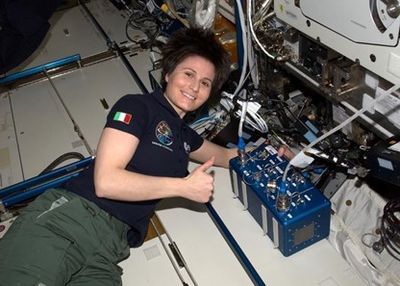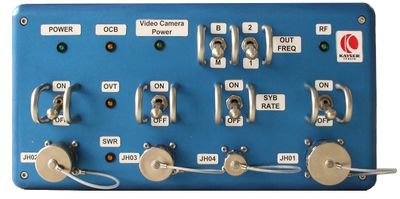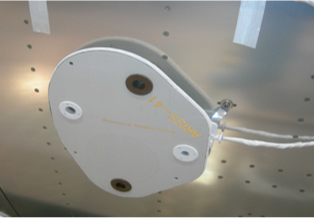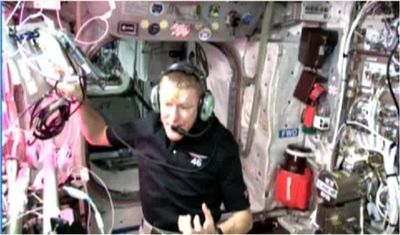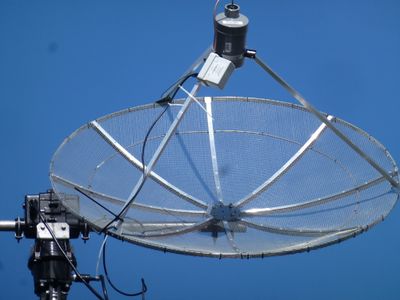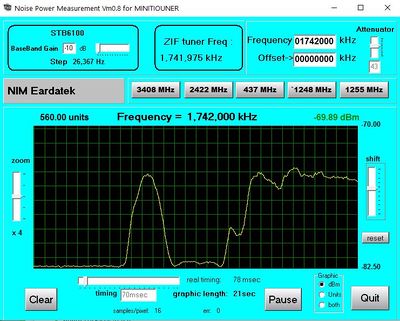HAMTV from the ISS
The original HamTV unit was installed on the ISS in 2013 and commissioned in April 2014 and was used for a number of ARISS schools contacts in 2016 - 2018. The unit failed in 2019 and was shipped back to Kaiser Italia for repair.
Following repairs carried out last year it now looks likely that the original HAMTV unit will be returned to the ISS with potential commissioning by a visiting astronaut during Spring 2024.
What is HamTV
HAMTV is the name of the Digital Amateur Television (DATV) transmitter on board the Columbus module of the International Space Station (ISS).
It transmits Digital video and audio in MPEG-2 format using the DVB-S protocol in the 13cms band.
HAMTV specifications
Ham Video downlink frequencies
- 2395 MHz (main operating frequency)
- 2369 MHz
- 2422 MHz
- 2437 MHz
DVB-S modulation
- Symbol rates: 1.3 Ms/s and 2.0 Ms/s
- FEC : ½
RF output
The HAMTV transmitter produces 10 watts RF, however this is then fed through a series of interconnecting cables and bandpass filter before passing through the ISS Columbus module external wall. Estimated power at the antenna is ~ 2 watts.
HAMTV antenna
The HamTV transmission runs relatively low power on 2395MHz to a simple patch antenna on the ISS.
This patch antenna is located on the earth side of the ISS but is surrounded by solar panels, thermal radiator panels, two or more visiting vehicles and robotic arms.
The ISS also “flies” slightly nose down to protect the cupola windows from space debris and so the RF performance, particularly when it is rising from the west, is slightly unpredictable.
The transmissions are right hand circular polarised (RHCP)
Video format
- NTSC
- SIF resolution: 352×240 or D1:720×480
What is HAMTV used for?
The primary use is during ARISS schools contacts, when the astronaut will use a camera to show himself and the inside of the ISS during the VHF radio contact.
It is hoped that test patterns, including JPEG images, will be transmitted when the cameras are not in use.
When will HAMTV be "on the air"?
It is unlikely that the HamTV transmitter will be on air 24/7.
During the first flight on the ISS between 2014 and 2018 it was used primarily for ARISS schools contacts but transmitter was left on at other times but no video was transmitted. This did allow groud stations to test their receive equipment and it is hoped a test signal generator will be included when it is re commissioned in 2024.
Once re-commissioned it will be tested before contacts and will be added to the Amsat status page https://www.amsat.org/status/
How to receive HAMTV?
There are a number of challenges to receive HAMTV from the ISS and a typical ground station is made up of the following elements
A typical groundstation system block diagram
Ground station antenna
The HamTV transmission runs relatively low power on 2395MHz to a simple patch antenna on the ISS. This patch antenna is located on the earth side of the ISS but is surrounded by solar panels, thermal radiator panels, two or more visiting vehicles and robotic arms. The ISS also “flies” slightly nose down to protect the cupola windows from space debris and so the RF performance, particularly when it is rising from the west, is slightly unpredictable.
This means an antenna with reasonable gain is required to receive the signal and whilst it is possible to receive the signal on a simple antenna when the ISS is overhead, to enable more than 5 minutes of reception, a higher gain antenna such as a dish with an efficient feed system is required.
A 1mt or larger dish is optimum but smaller antennas such as flat plate or patch antennas will work and have the advantage of a wider beamwidth making it easier to track the ISS.
Pre-amp and filter
A low noise pre-amp with bandpass filter tuned to 2395MHz should be connected directly to the antenna feed point to minimise co-ax losses.
Note that 2395MHz is only 5MHz below the 2.4GHz WiFi Channel 1, so good filtering will be needed to prevent WiFi from getting into the wide band satellite tuner.
If you are powering the LNA at masthead up the co-ax, you will need to place the DC inserter AFTER the filter.
If you are using a downconverter, a bandpass filter at the IF frequency in L band is possible.
Do I need a downconverter
The HAMTV frequency on 2395MHz is outside the frequency range of a standard consumer set top box or satellite tuner.
Unless you are using the BATC MiniTiouner Mark 2 or PicoTuner USB receiver equipped with the Serit 4434 NIM, which can tune up to 2450MHz, you will need a frequency down converter to place the HAMTV signal between 950 and 2150MHz which is within the range of a standard satellite receiver.
Note: The MiniTiouner Mk1 PCB with a Sharp or Eardertek tuner does NOT cover 2395MHz and will require a downconverter.
The downconverter should be placed between the low noise amplifier and satellite receiver – placing it at the masthead will mean that lower grade feeder can be used to bring the IF signal back to the shack.
Previous suppliers of a suitable down converter, such as Kuhne Electronics, no longer market suitable downconverters and BATC strongly recommends purchasing a new USB tuner hardware using the Serit 4334 tuner rather than building or sourcing a down converter - see next section on HamTV receivers.
Digital receivers for HAMTV
The HamTV transmissions can be received using a DVB-S receiver capable of decoding 2 Msymbol / second MPEG2 transmission. This means that a standard consumer Set Top Box (STB) can be used. However, because the signal is only available during the ISS pass it is essential to use a receiver that can be set to both the frequency and symbol rate before the pass.
A receiver, such as a typical consumer STB, that need to scan the frequency is unlikely to lock to the signal in the time available during the pass.
Receivers designed for DATV
Hardware
Ideally a receiver designed for receiving DATV signals should be used. The BATC Minitiouner and PicoTuner are PCBs which host the Serit 4334 satellite tuner and a USB interface. This unit is designed to be built at home, requiring only intermediate skills and does not use surface mount components.
The hardware is connected to either a PC or Raspberry Pi 4 using the USB 2 connection.
As mentioned above, the original BATC MiniTiouner Mk1 PCB launched in 2015 with a Sharp or Eardertek tuner does NOT cover 2395MHz and will require a downconverter. As well as covering the HAMTV frequency without a down converter, the Serit 4334 has much better RF performance than the original Sharp and Eardertek units and has been integrated into the OpenTuner and Portsdown DATV receive systems.
Software
When the original HAMTV was on the air, due to a problem with the DVB tables in the transmission, the MiniTiouner software by F6DZP running on Windows had to be used.
During the last 8 years many developments have taken and so we have a choice of software:
- Ryde - Raspberry Pi 4 based set-top box software designed specifically for DATV
- Portsdown -
- Opentuner
- MiniTiouner - the MiniTiouner software is still available however the author F6DZP is no longer involved in the amateur radio community so is not providing support or enhancements and you can no longer register on the Viva DATV forum to download the software.
Finding the signal
Always check the HamTV transmitter status before attempting to align your system as it is unlikely that it will be left on 24/7 and it certainly will not be available when EVAs (space walks) and docking of space craft are happening. It is likely but not confirmed that the status will be published on the ARISS international website and Twitter account – the ISSfanclub website may also have the status updates.
Tracking the ISS
Perhaps the most challenging aspect of receiving HamTV is that, unlike the QO-100 satellite available in the Europe and Africa, the ISS is not geo-stationary and orbits the earth every 96 minutes and is visible at any location for a maximum of 11 minutes.
In order to track the ISS, an azimuth and elevation rotator system is required. The most commonly used system is the Yaesu G5500, which is capable of rotating a 1.2m dish with a 5 degree beam width to track the ISS. When choosing/designing your system remember the ISS does go north of 50 degrees and so any system will need to be capable of flip mode to track it when it goes overhead.
Computer software is required to control the rotator system – there are a number of programs out there but I prefer PSTrotator which is a very versatile system with almost unlimited number of interfaces to control rotators.
Testing your system
As the ISS is not visible every day at a given location and then only for short periods, it is difficult to see if your HAMTV receive system is working.
There are a number of tests you can do to ensure your system is optimised but the most useful is to measure the sun noise received on your system. This will not only measure your system performance but if you leave it running for a few hours with your rotator control system set to track the sun, it will confirm the accuracy of your tracking system.
Measuring sun noise
Measuring sun noise can be done using SDR software running in continuum mode and running a program such as spectra view on the audio output – a Google search for sun noise measurement will show several techniques.
Alternatively, the Portsdown DATV transceiver and test system has a continuous noise measurement facility designed to measure sun noise and is very simple to use. Simply connect your Pluto or Lime SDR to the Pi4 USB port and run the software -
F6DZP developed a suite of programs to help test a HamTV receive system which included a Noise Power Measurement program (see CQ-TV253 page 27 for more details). This was available as part of the MiniTiouner v0.8 package but appears to have been dropped in later releases. The program can be used to measure the noise power received by a Serit 4334 tuner over a period of time and requires no extra software or equipment to make sun noise measurements – the picture shows the sun noise recording from a RFHams 1.2 m mesh dish used to receive HamTV for the Principia mission in 2016.
Decoding a local signal
Once you have checked your system sun noise and tracking accuracy it is worth testing you’re your system can receive a locally generated 2Ms DVB-S signal on 2395 MHz. You can use the Portsdown Pi4 based system with a Pluto or Lime SDR to generate this signal.
If this is successful you should be set to receive HamTV!
Receiving HamTV
All that remains is to wait until it is confirmed that the HamTV transmitter has been turned on then set your tracking program to follow the ISS and wait for the magic signs on the spectrum display (BandViewer?) or lock indicator that you are receiving the signal!
Once you have successfully received the HamTV transmission, the Dsave button in MiniTioune can be used to record data such as RF level, MER and Vber to show how well and for how long you received the pass.
Further information
BATC have setup a new forum thread to discuss receiving HamTV. Please post any questions, comments and status updates here:
https://forum.batc.org.uk/posting.php?f=2&mode=post&sid=9c1b12a07706567454ebeca685548796
Receivers compatible with HamTV:
A lot of information is available on the BATC forum:
https://forum.batc.org.uk/viewtopic.php?t=4389
Colin G4KLB made a video on how he received HamTV
